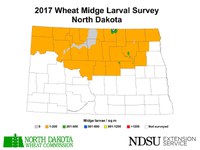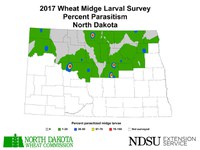2018 Wheat Midge Forecast Lowest on Record
(Click an image below to view a high-resolution image that can be downloaded)
Soil samples in North Dakota indicate low levels of overwintering wheat midge larvae (cocoons) for the 2018 season, according to Janet Knodel, North Dakota State University Extension Service entomologist.
A total of 201 soil samples were collected from 21 counties in the fall of 2017 to estimate the regional risk for wheat midge in 2018. The distribution of wheat midge is based on unparasitized cocoons found in the soil samples.
“Less than 1 percent of the soil samples had economic population densities of wheat midge (greater than 500 midge larvae per square meter) this past year,” Knodel says. “The hot spot was located in one soil sample in northeastern Rolette County in north-central North Dakota. The majority of the soil samples, 75 percent, had zero wheat midge cocoons, which is a record low for the wheat midge larval survey since its inception in 1995.”
Knodel adds, “This is good news for North Dakota wheat producers as it will reduce the likelihood that insecticide will be needed for wheat midge control in wheat in 2018.”
Wheat midge populations ranged from zero to 1,321 midge larvae per square meter, with an average of 24 larvae per square meter in 2017. In 2016, wheat midge populations were slightly higher than 2017, ranging from zero to 2,071 midge larvae per square meter, with an average of 42 larvae per square meter.
“Other areas with low wheat midge populations (200 to 500 larvae per square meter) occurred in small, localized areas in northeastern Eddy and Wells, and south-central Ramsey counties,” says Knodel. “These population levels are still considered noneconomic and low risk for wheat midge.”
Knodel believes that the dry weather in the northwestern and north-central areas of North Dakota was extremely detrimental to wheat midge in 2017. Larvae are susceptible to dryness and require dew or rain to drop out of the wheat heads and dig into the soil to overwinter as cocoons.
Knodel adds, “Even with the low-risk forecast for wheat midge, it is wise to scout any wheat fields that are at risk from heading to early flowering ( less than 50 percent flowering) when wheat midge is emerging.”
A wheat midge degree day model predicts the emergence of wheat midge, and helps producers determine when to scout and if their wheat crop is at risk. Producers can access the wheat midge degree day model on the North Dakota Agricultural Weather Network (NDAWN) website at http://bit.ly/WheatDegreeDays.
Select your nearest NDAWN station and enter your wheat planting date. The output shows the expected growth stage of the wheat and whether it is susceptible to midge infestation, as well as how far along the wheat midge emergence is, such as 50 percent females emerged. Scouting for the orange adult flies is conducted at night when temperatures are greater than 59 F and the winds are less than 6 mph. Use a flashlight and slowly scan the heads of wheat plants for wheat midge adults, counting the number of flies per head.
The economic thresholds for wheat midge are one or more midge observed for every four or five heads on hard red spring wheat, or one or more midge observed for every seven or eight heads on durum wheat.
Knodel says, “The sad news for 2017 is that the beneficial parasitic wasp, Macroglenes penetrans, which naturally controls wheat midge eggs and larvae, continues to be at record lows, with only a 4.2 percent parasitism rate in 2017, 4.8 percent parasitism rate in 2016 and 3.7 percent parasitism rate in 2015. Ninety-two percent of the larval cocoons had zero incidence of parasitism in 2017, and was similar to the levels in 2016 and 2015, with 89 percent and 91 percent, respectively.”
The highest parasitism rates were found in Bottineau, McLean and Wells counties. Because the parasitic wasp is dependent on its host, wheat midge, its populations decreased as midge populations also decreased in the past few years.
Knodel emphasizes, “We need to continue to conserve parasitic wasp populations when possible by spraying insecticides only when wheat midge populations are at economic threshold levels and avoiding any late insecticide applications to minimize the negative impacts on parasitic wasps that are active at that time. This tiny, metallic wasp does an excellence job keeping the wheat midge in check by providing free biological control of wheat midge in wheat fields.""
NDSU Extension Service agents collected the soil samples. The North Dakota Wheat Commission supports the wheat midge survey.
For more information on the integrated pest management of wheat midge in North Dakota, view the related NDSU Extension publication at http://bit.ly/NDSUWheatMidgePub.
NDSU Agriculture Communication – February 15, 2018
| Source: | Janet Knodel, 701-231-7915, janet.knodel@ndsu.edu |
|---|---|
| Editor: | Kelli Anderson, 701-231-6136, kelli.c.anderson@ndsu.edu |



